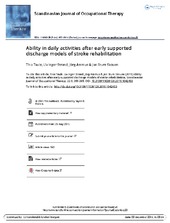| dc.contributor.author | Taule, Tina | en_US |
| dc.contributor.author | Strand, Liv Inger | en_US |
| dc.contributor.author | Assmus, Jörg | en_US |
| dc.contributor.author | Skouen, Jan Sture | en_US |
| dc.date.accessioned | 2015-12-10T10:08:17Z | |
| dc.date.available | 2015-12-10T10:08:17Z | |
| dc.date.issued | 2015 | |
| dc.identifier.issn | 1103-8128 | |
| dc.identifier.uri | https://hdl.handle.net/1956/10730 | |
| dc.description.abstract | More knowledge is needed about how different rehabilitation models in the municipality influence stroke survivors’ ability in activities of daily living (ADL). Objectives: To compare three models of outpatient rehabilitation; early supported discharge (ESD) in a day unit, ESD at home and traditional treatment in the municipality (control group), regarding change in ADL ability during the first three months after stroke. Methods: A group comparison study was designed within a randomized controlled trial. Included participants were tested with the Assessment of Motor and Process Skills (AMPS) at baseline and discharged directly home. Primary and secondary outcomes were the AMPS and the modified Rankin Scale (mRS). Results and conclusions: Included were 154 participants (57% men, median age 73 years), and 103 participants completed the study. There were no significant group differences in pre–post changed ADL ability measured by the AMPS. To find the best rehabilitation model to improve the quality of stroke survivors’ motor and process skills needs further research. Patients participating in the ESD rehabilitation models were, compared with traditional treatment, significantly associated with improved ADL ability measured by the mRS when controlling for confounding factors, indicating that patients with social needs and physical impairment after stroke may benefit from ESD rehabilitation models. | en_US |
| dc.language.iso | eng | eng |
| dc.publisher | Taylor & Francis | eng |
| dc.relation.ispartof | <a href="http://hdl.handle.net/1956/10736" target="blank">Stroke rehabilitation in the context of early supported discharge. Quantitative and qualitative aspects of daily life after mild-to-moderate stroke</a> | |
| dc.rights | Attribution- NonCommercial CC BY-NC | eng |
| dc.rights.uri | http://creativecommons.org/licenses/by-nc/4.0/ | eng |
| dc.title | Ability in daily activities after early supported discharge models of stroke rehabilitation | en_US |
| dc.type | Peer reviewed | |
| dc.type | Journal article | |
| dc.description.version | publishedVersion | en_US |
| dc.rights.holder | Copyright 2015 The Author(s). | |
| dc.identifier.doi | https://doi.org/10.3109/11038128.2015.1042403 | |
| dc.identifier.cristin | 1258514 | |
| dc.source.journal | Scandinavian Journal of Occupational Therapy | |
| dc.source.40 | 22 | |
| dc.source.14 | 5 | |
| dc.source.pagenumber | 355-365 | |

